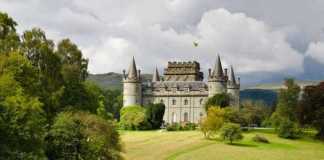Portugal is a land of contrasts and offers something to suit all tastes. The capital city, Lisbon, on the Atlantic coast, combines ancient history with modern thinking and gives visitors the opportunity to visit churches, museums, a fort, and a castle while offering a buzzing nightlife and fantastic food. If you are a sun and sea worshipper, head to the Algarve on the south coast which has some lovely resorts dotted along the coastline. It offers long white sandy beaches and a myriad of water activities. Then there is Porto, which has become famous for the port it produces. If you enjoy a glass of port, don’t miss taking a boat ride on the Douro River to visit some wineries.
The weather in Portugal is idyllic. In the centre and south of the country, the climate is Mediterranean with hot, dry, summers and mild, wet winters. The summers are very warm in the north, but the winters can be colder. If you have decided to visit Portugal but are unsure of where to go, I am here to help you out. I have put together two itineraries which take you to different parts of the country, although both start in Lisbon, a stunning city which should be visited, especially on your first visit to the country. First, I’ll give you some tips about Portugal which will help to make your trip enjoyable and hassle-free.
Contents
Planning Your Portugal Itinerary
Best Time To Visit
If you love the heat, summer in Portugal will suit you, however, June, July, and August are crowded and flights, accommodation and car hire are generally at their highest.
If you want to visit outdoor historical sites, it is best to go early in the morning before the heat of the midday sun sets in and before the crowds arrive.
Spring and late summer/early autumn are lovely times to visit Portugal when the weather is still good, but it isn’t baking hot, and it isn’t as crowded.
Prices for accommodation and car hire are cheaper than in the summer.
You can also enjoy the beaches, museums, castles and wineries without the frantic rush of the summer months.
Winters can be unpredictable when it comes to the weather as it can rain, but you can also have lovely warm sunny days.
It is a great time for sightseeing as there aren’t as many tourists around, but it isn’t beach weather. Expect temperatures between 9 and 17C (49 – 63F).
How To Get To Portugal
Portugal has three international airports, Lisbon, Porto and Faro.
The national airline is TAP Air Portugal but many other airlines fly to the country, both scheduled and budget, such as Easyjet.
If you are travelling within Europe, there is an excellent train service that goes to Portugal.
You can get a Eurail or Interrail pass which gives unlimited travel for different time spans such as 15 days and even up to three months but there aren’t any international ferries that travel to Portugal.
Finding Accommodation
If you intend to travel in the high season, I recommend booking ahead as there is a high demand for rooms.
If you are travelling in the spring or autumn seasons, you should be able to find accommodation when you get there but if you are travelling from one town to the other, you may spend too much time looking for accommodation, time which could be better spent relaxing on the beach or sightseeing.
Good sites for booking accommodation include Booking.com, Trivago, and Airbnb.
Getting Around
You will find that the main cities have an efficient public transport system.
Lisbon has the metro, trams, buses, trains, and even funiculars due to its hilly terrain.
To save money, opt for a Lisboa card which gives you free use of public transportation as well as free or discounted access to sites such as the Ajuda Palace and the National Archaeological Museum.
You can choose to have a card for 24 hours, 48 hours, or 72 hours. The longer you buy the card for, the cheaper it gets, and there are discounts for children.
Order it online to save time and then pick it up at the airport.
Porto also offers discounted travel within the city.
The Andante card gives you unlimited access to the metro and buses, as well as to some trains. They last for either 24 or 72 hours.
If you plan to do some sightseeing, I recommend that you get the Porto card, which, as well as giving you unlimited access to public transportation, gives you discounts to sites and museums.
You can purchase the card for anywhere between one and four days and you can also buy one just for sightseeing, without public transportation.
There are buses in Faro but it is a small town and most of the sites are in the centre so you can walk.
While it is easy to get around the major cities and between them by either train or long-distance buses, if you want to go to smaller villages and beaches, buses are infrequent.
It is nearly always better to hire a car if you want to explore further afield.
Driving is pretty straightforward in Portugal and shouldn’t cause you anxiety unless you decide to drive in Lisbon or Porto where I recommend that you take public transport.
Taxis are also aboundant and are reasonably priced.
Paying and Tipping
Portugal uses the euro and while most places accept credit cards, if you go off the beaten track, restaurants, cafes, and shops may only take cash.
In addition, even in the cities, some places will only accept credit cards if you spend a certain amount, such as 10 euros or 20 euros.
You won’t have too much trouble finding ATMs in the cities and towns but stock up on cash if you are heading to smaller villages.
There isn’t a tipping rule in Portugal as there is in countries like the US where you are expected to tip.
It is, however, appreciated, and in a restaurant, 10% is the norm but don’t tip if you get bad service.
It is customary to tip in a hotel and a euro per bag is sufficient for bell staff.
When it comes to taxis, 5 – 10% is sufficient and when you do leave a tip, give cash so that the appropriate people get the tip.
Food In Portugal
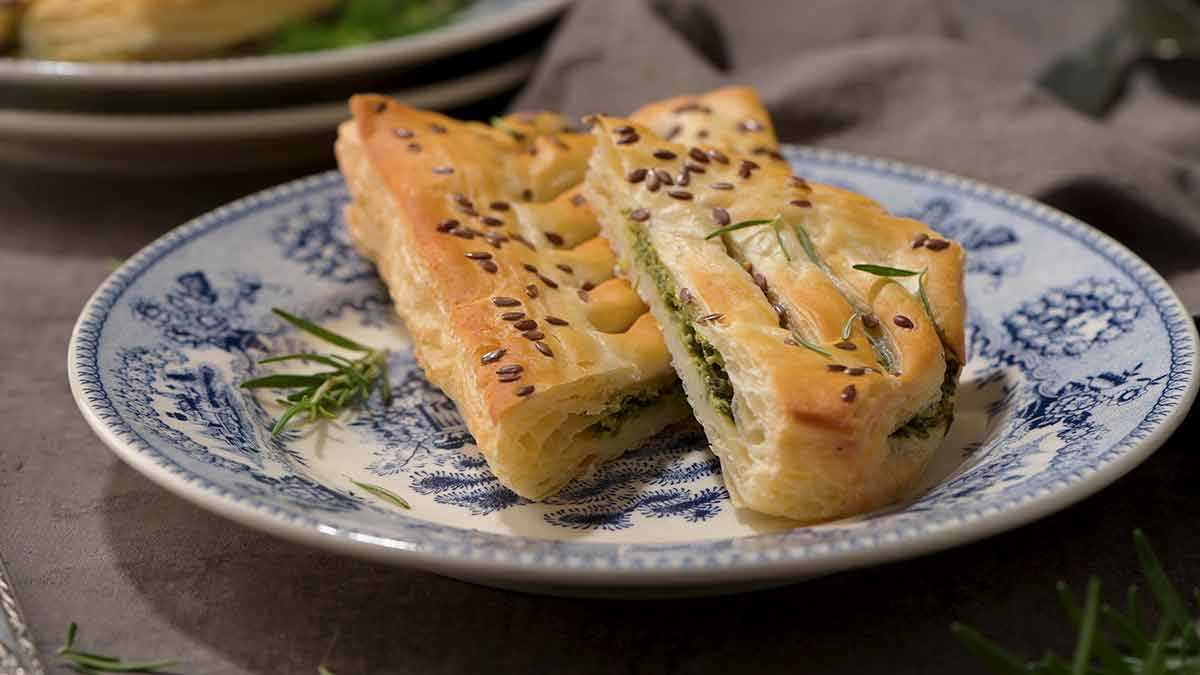
The Portuguese love to eat and enjoy long leisurely meals so don’t expect to be rushed in restaurants.
You will have to ask for your bill otherwise you will be left alone.
Wine accompanies most meals and is often locally produced.
Traditional Portuguese food is hearty and full of flavour.
Centuries ago, explorers went searching for new countries and brought back with them spices and other ingredients which changed the food perspective in the country.
The food you will taste has been influenced by the Mediterranean, Africa, Brazil, and the Spice Route.
Try the piri piri chicken which is a chicken barbecued with a sauce of spices including hot chillies.
Fish is an important ingredient in Portuguese cookery which isn’t surprising due to its proximity to the sea, the Atlantic on the west coast, and the Mediterranean to the south.
Bacalhau, which is salted cod, is considered to be the national dish but there are said to be around 365 ways of cooking it, for example, bacalhau a bras, which is shredded cod with onions, eggs, and fries, and bolinhos de bacalhau which are cod fritters.
Grilled sardines are also very popular and you will find street vendors cooking them over hot coals during the summer.
This makes them crispy on the outside and succulent inside.
A popular dish and one that should be tried if you are a meat eater is porco preto or Iberian black pork.
The meat is made from organic black pigs which lead as free a life as is possible, eating mainly acorns.
The meat is mouthwatering and slightly nutty.
It doesn’t need any other cooking than just being simply grilled.
If you are in Porto, take up the challenge of having a Francesinha sandwich.
It is a meat-lovers dream but it is not for the faint-hearted as it is enormous.
Packed inside the bread is wet-cured ham, linguica, which is a spicy sausage, and steak.
It is covered in melted cheese with a hot tomato and beer sauce and a fried egg on top. You may like this food tour.
The most popular dessert is the pastel de nato or custard tart.
Pastry shells are filled with custard and dusted with cinnamon.
It is believed that they were created by monks from the Jeronimos Monastery in Belem.
If you are vegetarian or vegan, things are getting easier in Portugal.
If you are in the major cities and towns, you are likely to find some vegetarian and vegan restaurants.
Other restaurants have been adding vegetarian options to their menus but the choice might not be great.
However, once you get off the beaten track, you may have more difficulty in finding plant-based food.
International restaurants can be found in the cities and larger towns, such as Indian, Chinese, Arabic, and Italian.
Itinerary 1 – Lisbon – Porto
Day 1 – Lisbon
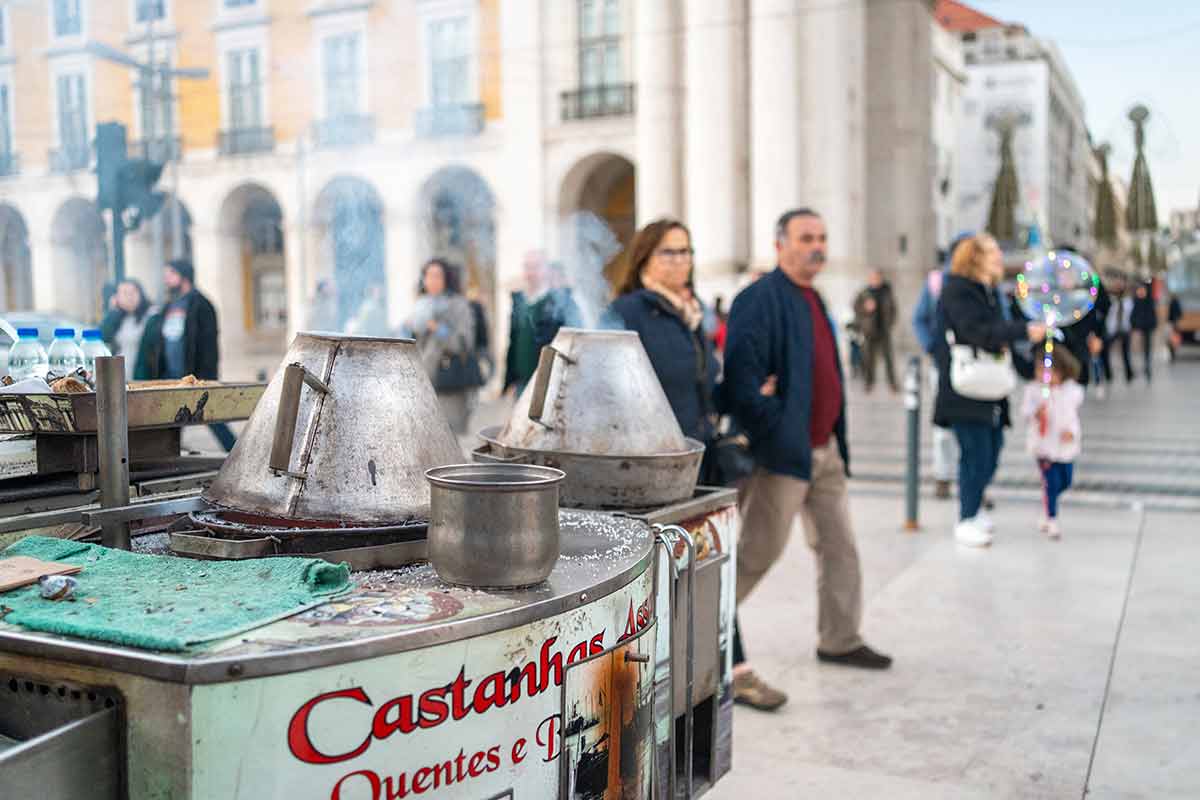
A good way for you to acquaint yourself with Lisbon is to take a morning tour of the city.
The tour I have suggested takes you to such places as the Mannerist and Baroque-style San Roque Church, the Gothic Carmo Convent, the National Pantheon and Lisbon Cathedral.
It lasts for three hours and you end up in the Alfama district, the oldest and most charming neighbourhood in the city.
It dates back to the Middle Ages and has cobbled streets and traditional houses.
It is a great place to have lunch.
After lunch, hike up to the Sao Jorge Castle which is at the top of the Alfama district.
You can take a stroll around the castle gardens from where you will be able to enjoy fantastic views of the city and of the River Tagus.
You are also able to walk along the high walls of the castle keep, from where you also get great views.
I suggest having dinner in the Bairro Alto district as there are many fado restaurants and bars there.
Fado is the Portuguese traditional music and singing which will envelop you in the spirit of the country.
Day 2 – Lisbon
Spend the day in the Belem district, the southwesternmost neighbourhood of Lisbon.
It is quieter than the city centre, with parks, riverside walks, and plenty of attractions.
First head to the Jeronimos Monastery, a UNESCO World Heritage Site.
Get there early as it is popular and can get crowded, especially during the summer months.
The monastery was built in the Gothic style both outside and in the inner cloisters.
In the church, which has a stunning ornate ceiling, you will see the burial place of the famous explorer, Vasco de Gama.
Wander around the beautiful monastery gardens and then go to the Monument of the Discoveries.
It is shaped like a ship and has famous Portuguese faces carved on it, including explorers, scientists, and poets.
You can climb to the top of the monument from where you will have panoramic views of the monastery and the river.
After lunch, take a stroll along the riverfront and to the Belem Tower, a fortification built in the Middle Ages and which guarded the river approach to the city.
You can purchase a ticket and then cross the boardwalk to the tower.
Climb the tower for fantastic views.
If you have time after visiting Belem, head to the 25 de Abril Bridge, a magnificent suspension bridge linking the city centre to the Alfama district.
You can’t cross it on foot but you can get either the 728 or 753 bus to go over it.
It is similar to the San Francisco Golden Gate Bridge and just as spectacular.
The bridge is close to the LX Factory which is a giant art space with great shops, bars, cafes, and restaurants.
LX Factory is at Rua Rodrigues Faira 103, AlcAntara.
Day 3 – Lisbon
Take a day trip to Sintra, Pena, Regaleira, and Cascais.
Enjoy the Sintra-Cascais Nature Park, visit Quinta da Regaleira, a UNESCO World Heritage Site, which has beautiful gardens, sculptures, fountains, and a nine-storey spiral well, and then visit the fairytale Pena Palace.
It is a mix of styles including Neo-Gothic, Neo-Moorish, and Indo-Gothic. End the tour by relaxing in the attractive fishing village of Cascais.
Day 4 – Lisbon – Obidos
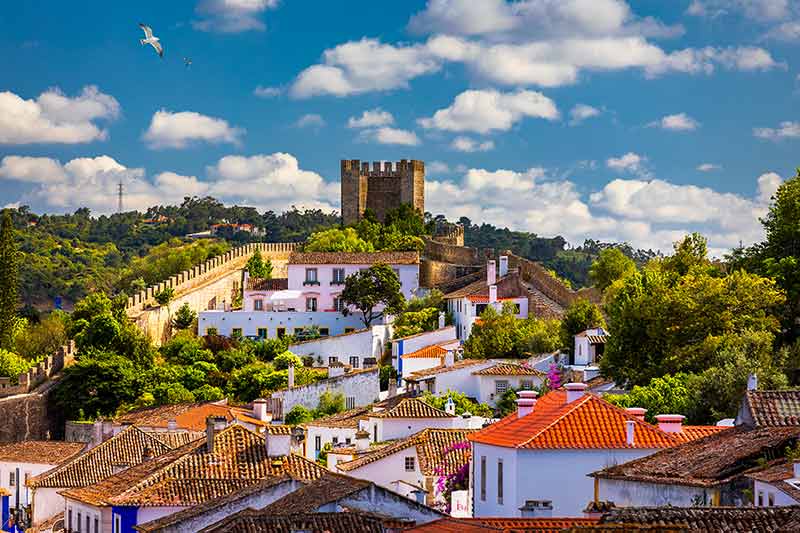
For your trip from Lisbon to Porto, I suggest that you hire a car so that you can make all the stops I have suggested.
There are buses between many of the towns and villages but they take a long time and sometimes you have to change buses.
You probably won’t be able to fit in all the places I recommend that you visit.
First drive to Ericeira which is 53 km (33 miles) from Lisbon, stopping in the village of Mafra to visit the Mafra National Palace, another UNESCO World Heritage Site.
It comprises both a palace and a monastery.
The royal apartments are beautifully decorated and the basilica is spectacular.
The architectural design is a combination of Baroque and Neo-classical.
Have lunch in Ericeira and perhaps take a swim as the town is by the sea.
Alternatively, after lunch, head to Peniche which is 96.5 km (60 miles) away.
It has a small archipelago close to called the Berlangas Nature Reserve.
Between May and October, there are boats which will take you there.
Finally, head to Ibidos for the night. It is just 25.58 km (15.9 miles) inland from Peniche.
The town was built in the Middle Ages and has an ancient wall surrounding it.
You can walk on the walls for spectacular views.
Obidos is a great palace for dinner as there is a variety of restaurants to be found, from rustic eateries to fine dining.
Day 5 – Obidos – Tomar
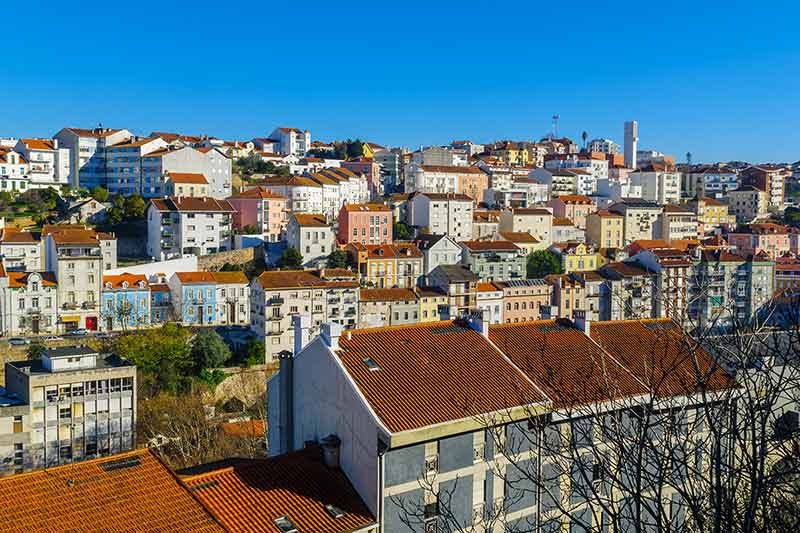
Today starts with a drive to Nazare by the Atlantic Ocean.
It is 40.55 km (25.2 miles) from Obidos and is a small town with big waves!
You may see seasoned surfers taking advantage of these waves.
The best place to see them is from the upper town at the Forte de Sao Miguel Arcanjo.
You get there in a cable car which saves you from walking uphill in the heat.
There are some interesting and quirky museums to be found in the town including the Big Wave Museum and the Dried Fish Museum.
Have lunch in Nazare, which is a seafood lover’s paradise, especially as it is usually freshly caught on the day.
The next stop is a famous pilgrimage site, Fatima, where three children said that they saw three apparitions of angels and six of the Virgin Mary.
It is 61.79 km (38.4 miles) from Nazare.
Visit the spectacular Neo-Baroque Basilica and the oak tree where the Virgin Mary was supposed to have appeared.
There is a path in front of the Basilica where believers walk on their knees.
A statue of the Virgin Mary is housed in a glass chapel.
Then head to Tomar, which is 37.65 km (23.4 miles) from Fatima.
Have dinner and spend the night there.
It is a mediaeval town and you can even eat in a mediaeval restaurant.
Day 6 – Tomar – Coimbra
Spend the day exploring Tomar.
It is an attractive town with plenty to see and do.
Visit the Convent of Christ which has beautiful mediaeval cloisters, and the Castle of Tomar which has stunning views.
Together, these two buildings form a UNESCO World Heritage Site.
Explore the Old Town with its narrow streets or take a stroll in the Forest of the Seven Hills which is within the town.
There are plenty of restaurants in Tomar, including Mediterranean, Portuguese, Latin American, and even Italian.
You will be spoilt for choice.
In the late afternoon or whenever you have seen all you want in Tomar, head to the town of Coimbra, Portugal’s university city, for the night.
It is 88.5 km (55 miles) away.
Day 7 – Coimbra- Porto
Take a walking tour of Coimbra which will take you to many sites such as the university, which is the oldest in Europe, monasteries, and cathedrals.
In the afternoon, drive to Porto which is 117 km (73 miles) away.
A good district to have dinner in is Ribeira.
There is a great combination of Portuguese and international restaurants to choose from, such as Latin American, Mediterranean, and Italian.
Day 8 – Porto
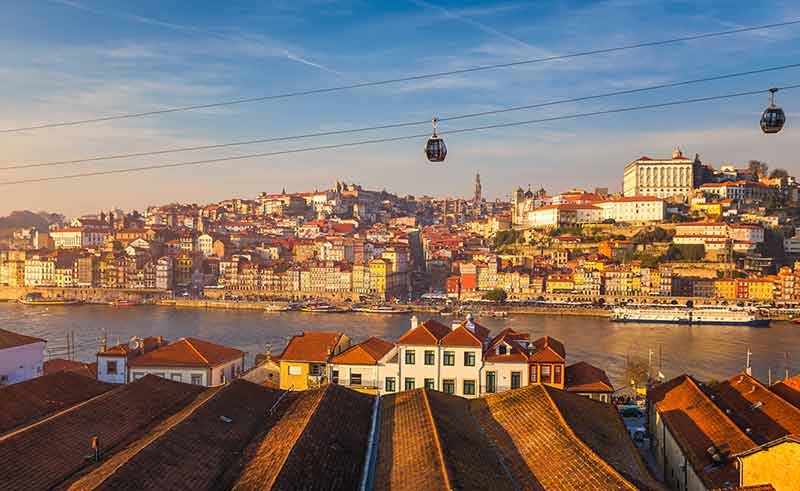
Explore Porto with the Porto card, which gives you free transportation and 150 discounts and benefits, including seven free museums, or go on a guided tuk tuk tour.
Visit Porto Cathedral and the 19th-century Neoclassical Palacio da Bolsa which you can explore on a guided tour.
If you are an avid reader, go to the Livaria Lello, one of the most beautiful bookshops in the world with its Art Nouveau design.
Near to the bookshop is Clerigos Towers which you can climb and there are 225 steps but you will be rewarded with spectacular views.
The food culture is varied in Porto and you can choose from Portuguese, Mediterranean, Italian, and other international cuisines.
There are vegetarian and even vegan restaurants in the city.
If you prefer to soak up the sun, head to the Foz do Douro district where the Douro River meets the Atlantic Ocean.
There are several sandy beaches here and a lovely promenade and a cruise is another great way to explore.
Day 9 – Porto
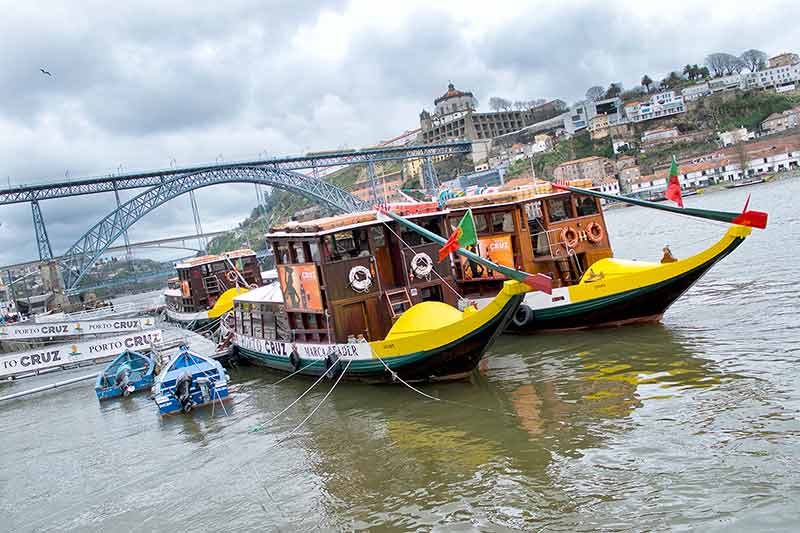
Take a day trip to the Douro Valley where there are wineries producing port.
Port is produced exclusively in the Douro Valley and is a delicious after-dinner drink.
The tour lasts for 10 hours and takes you to two wineries for tastings and to see the vineyards.
You will have a traditional Portuguese lunch and also an hour’s boat trip where you will be able to enjoy the stunning scenery.
Also read:
- 20 Landmarks In Portugal
- Best Time To Visit Portugal
- 20 Portugal Beaches
- 16 Things To Do In Lisbon
- 20 Things To Do At Night In Lisbon
- 20 Things To Do In Porto
- 20 Day Trips From Porto
- 20 Things To Do In Portugal
- Christmas in Portugal
- 20 Best Cities in Portugal
- 20 Things To Do In Albufeira
- 20 Things To Do In Faro
- 20 Things To Do In Lagos
- 20 Things To Do In Sintra
- 20 Best Tours In Portugal
- 20 Things To Do In Braga
- Where To Stay in The Algarve
- 20 Things To Do In Aveiro
- 20 Things To Do In Coimbra
- Where To Stay In Lisbon
- 20 Things To Do In Portimao
- Where To Stay In Porto
- 20 Best Restaurants In Porto
- 20 Portuguese Food Dishes To Taste
- 15 Things Portugal Is Famous For
- 10-day Portugal Itinerary
Day 10 – Porto – Home
Either drive back to Lisbon to catch a flight home or fly from Porto. It is Portugal’s second-largest airport and serves 29 countries.
Itinerary 2 – Lisbon – Faro
Days 1 – 3 Lisbon
Acquaint yourself with Lisbon following Itinerary 1.
Day 4 – Lisbon – Evora
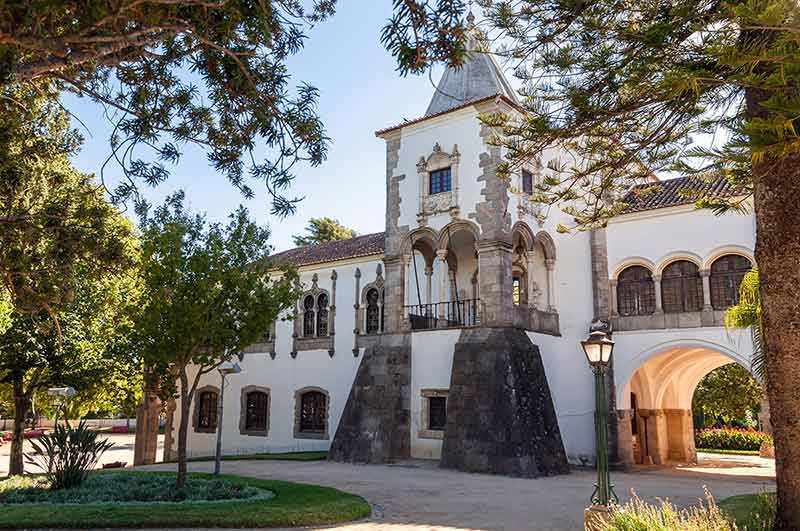
Again, it is better to hire a car than rely on buses as you wouldn’t be able to fit in all the interesting stops I am going to suggest in this itinerary.
If you decide that you don’t want to hire a car, you might have to leave out some of the stops.
Drive from Lisbon to Sesimbra, which is 39.59 km (24.6 miles) away and is within the Arrabida Natural Park.
Here you will find some beautiful secluded beaches.
If, however, sightseeing is your interest, visit the Forte de Santiago de Sesimbra and Sesimbra Castle, both of which have panoramic views.
The castle is free to enter and offers a small history museum and a cafe.
You will probably need a drink after hiking up to the castle which is 230 metres (754.6 feet) above sea level.
Have lunch in Sesimbra which has plenty of Latin American and Mediterranean restaurants, as well as a vegetarian cafe and a sushi restaurant.
In the afternoon drive the 28.6 km (17.8 miles) to Schibal where you can explore the Forte de São Filipe, a 16th-century castle which has some lovely dolphin sculptures.
Finally, drive inland to Evora.
It is 98 km (61 miles) away from Schibal.
There are plenty of Latin American and Mediterranean restaurants here, as well as an Italian restaurant, so you have plenty of choice for dinner.
Day 5 – Evora – Lagos
Take a morning guided tour of Evora.
I suggest the ‘Tales and Legends Guided Tour’ which isn’t scripted so it’s a surprise where you go.
There is plenty to see in Evora and you might visit the Ancient Roman Temple of Diana, dating to the 1st century, which is a UNESCO World Heritage Site.
Perhaps you will see the Cathedral of Evora, which took centuries to build and the Church of St. Francis, which houses the Chapel of Bones and is not for the faint-hearted.
The interior walls and ceiling are covered in human bones comprising around 5,000 skeletons.
Have lunch in the main square, the Praca do Giraldo, which has a lively atmosphere and then head to Lagos on the Algarve.
It is a long drive, 310.6 km (193 miles) so you will probably want to have a relaxing evening with a good meal.
There are plenty of restaurants to choose from including Latin American, Mediterranean, British, Thai, Chinese, and Mexican.
Day 6 – Lagos
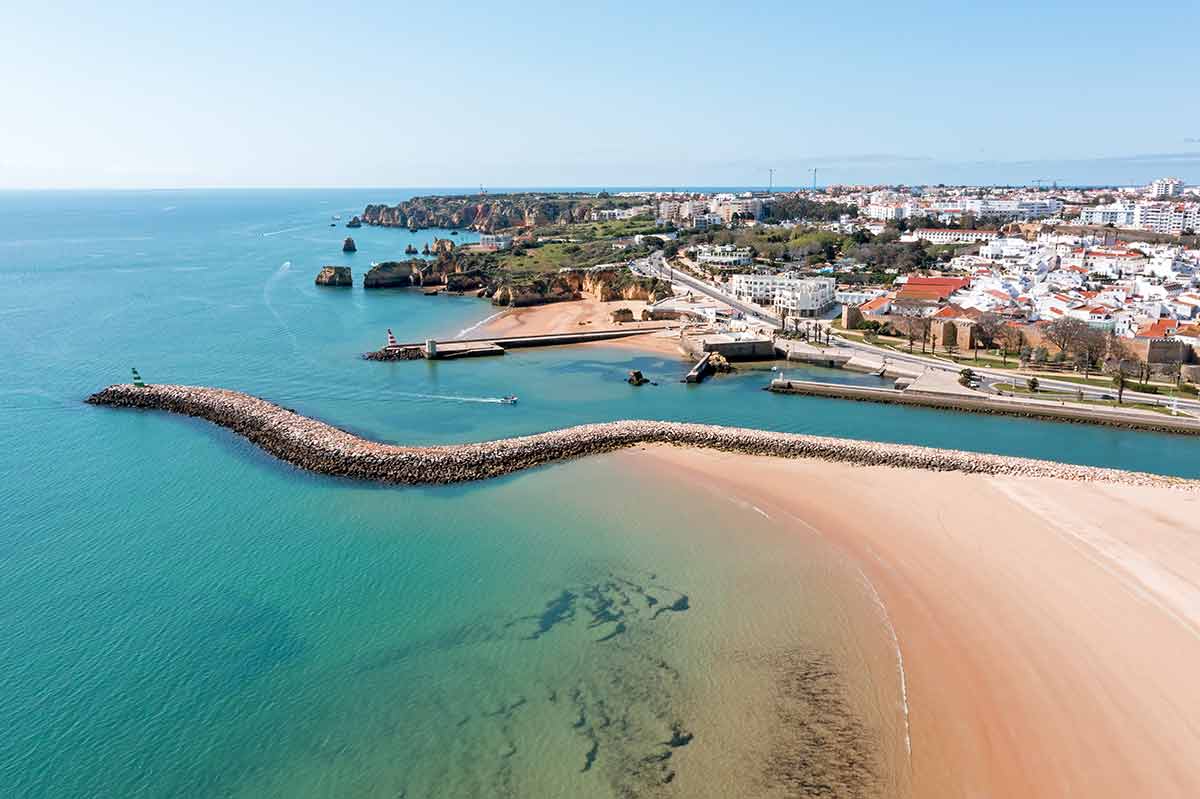
In the morning, go on a dolphin watching and Benagil Cave tour with a marine biologist who will tell you about dolphins.
Of course, it’s not guaranteed that you will see them but the chances are quite high.
You will go out into the Atlantic Ocean in search of these majestic creatures and then visit Portugal’s most famous cave.
It has two entrances, a skylight, aquamarine waters, and is a particularly good place for taking photographs.
Spend the afternoon on the beach or go on a guided kayaking tour.
In the evening, visit the Old Town with its narrow cobblestoned streets and have dinner in one of the many restaurants.
Day 7 – Lagos – Albufeira
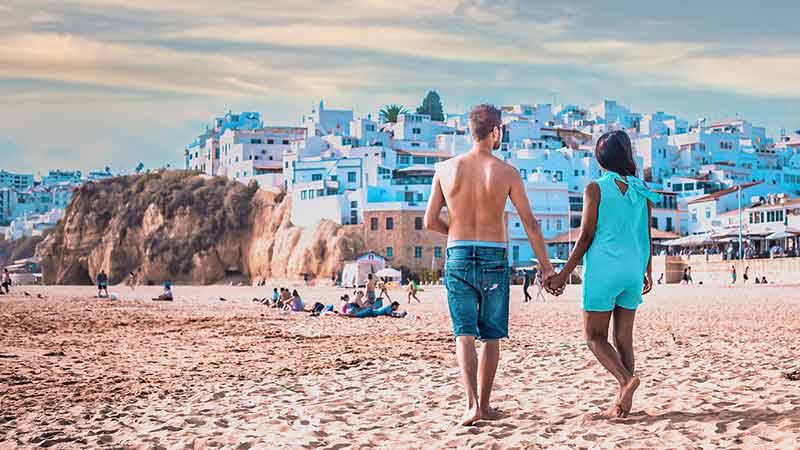
Take a half-day tour to Sagres and Cave St. Vincent, the most southwestern place in Europe.
In Sagres, you will have spectacular news from the fortress and at Cave St, Vincent, you will see where the Atlantic and the Mediterranean meet.
After lunch, drive to the seaside resort of Albufeira which is 58 km (36.1 miles) away.
Here you can relax on the beach for the rest of the afternoon.
You will find lovely red-gold sandy beaches and crystal-clear waters.
In the evening, you have the choice of spending it either in the Old Town or the New Town.
The Old Town is laid back and is great for leisurely walks and eating local cuisine.
If however, you are more interested in nightlife, head to The Strip in the New Town, which is packed full of bars and nightclubs.
Day 8 – Albufeira – Faro
Take a winery tour with wine tasting and tapas.
You will visit vineyards and the winery, where you will sample wine with typical tapas like cheese and charcuterie.
You will end the visit with a small glass of Portuguese firewater, Aguardente de Medronhos, together with a pastry.
Beware, it will burn your throat!
In the afternoon, drive to Faro, 45 km (28.5 miles) away.
I suggest that you enjoy an evening guided walking tour with food.
You will visit four different restaurants and try 10 traditional dishes with a drink at each restaurant.
It lasts for three hours and takes you to the old part of the city.
There are plenty of options for afterwards as there are many nightclubs and bars, some with live music.
Day 9 – Faro
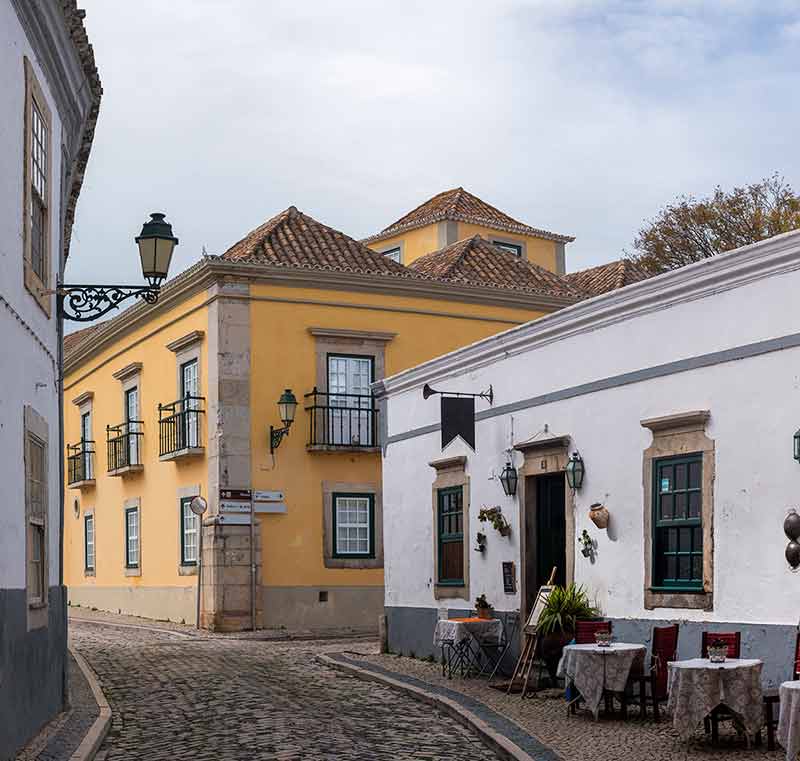
Spend the day exploring Faro. Visit the beautiful 13th-century Faro Cathedral with its intricate carvings and tower, which you can climb for amazing views.
The Igreja do Carmo Church has stunning stained glass windows and intricate wood carvings, as well as a macabre Chapel of Bones.
It is said that it is haunted.
Faro has plenty of art galleries and museums, such as The Maritime Museum and the Archaeological Museum.
The Musee do Faro is fun for the whole family as it teaches you about the history of Faro through games and interactive exhibits.
If, on the other hand, you just want to have a laid-back day, head to Praia de Faro, the main beach in the town.
It is one of the best beaches in the Algarve. It has white sand and offers a fantastic sunset.
If you are interested in ancient sites, take a trip to the Roman ruins of Milreu which will give you a good idea about Roman life.
There are remnants of a villa, a mausoleum, baths, and commercial buildings.
It is only 11 km (6.9 miles) away so won’t take long to get there.
Day 10 – Faro – Home
Either drive back to Lisbon to catch your flight home or get a plane from Faro if it serves your country.
If you want to explore more of Europe by train, you can get a train from Faro to Lisbon and then get an international train to various destinations in Europe.
Looking for more itineraries? Try these:
- 10-day Japan Itinerary
- Osaka Itinerary
- The Perfect Nagoya Itinerary
- Hong Kong Itinerary
- Macau Itinerary
- Taiwan Itinerary
- 5-day Beijing Itinerary
- 7-day Greece Itinerary
- 10-day Portugal Itinerary
- 3-day Paris Itinerary
- 10-day France Itinerary
- 10-day Southern Spain Itinerary
- 10-day Northern Spain Itinerary
- 10-day Ireland Itinerary
- 3-day Athens Itinerary
- 10-day Iceland Itinerary
- 10-day Thailand Itinerary
- Bali Itinerary
- San Francisco Itinerary
- Oahu Itinerary
- Galapagos Islands Itinerary
- Sweden Itinerary
- Balkan Itinerary
- Tasmania Itinerary
- Sri Lanka Itinerary
- Philippines Itinerary
- 3-day Shanghai Itinerary
- 10-day China Itinerary (Wildlife/Nature)
- 3-day Lisbon Itinerary
- 3-day Porto Itinerary
- 7-day Tuscany Itinerary
- 5-day Tokyo Itinerary
Plan Your Trip

Rent A Car – Find the best car rental rates at Discover Cars. They compare car hire companies to provide you with the best deal right now.

Find A Hotel – If you’re curious about this article and are looking for somewhere to stay, take a look at these amazing hotels.
